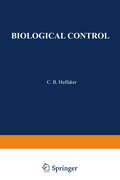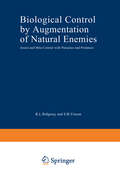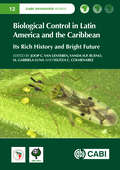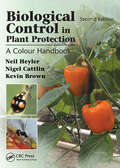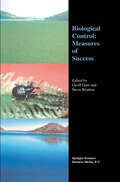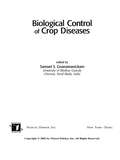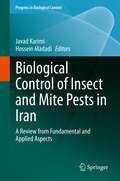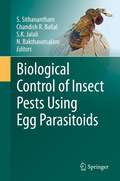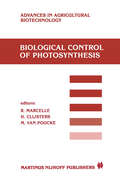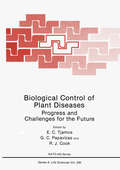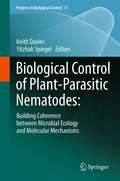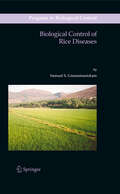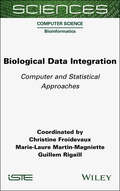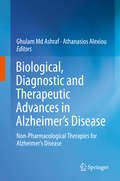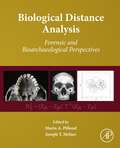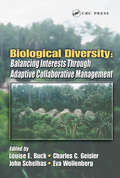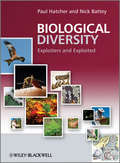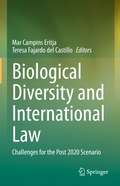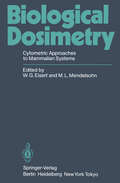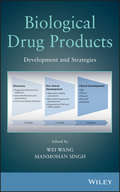- Table View
- List View
Biological Control: Proceedings of an AAAS Symposium on Biological Control, held at Boston, Massachusetts December 30–31, 1969
by C. HuffakerThe explosive increase in the world's human population, with conse quent need to feed an ever-increasing number of hungry mouths, and the largely resultant disturbances and pollution of the environment in which man must live and produce the things he needs, are forcing him to search for means of solving the first problem without intensifying the latter. Food production requires adequate assurance against the ravages of insects. In the last three decades short-sighted, unilateral and almost exclusive employment of synthesized chemicals for insect pest control has posed an enormous and as yet unfathomed contribution to the degradation of our environment, while our insect pest problems seem greater than ever. Properly viewed, pest control is basically a question of applied ecology, yet its practice has long been conducted with little regard to real necessity for control, and in some cases, with little regard to various detrimental side-effects or long-term advantage with respect, even, to the specific crop itself. This book deals fundamentally with these questions. The development of pesticide resistance in many of the target species, against which the pesticides are directed, has occasioned an ever-increasing load of applications and complexes of different kinds of highly toxic materials. This has been made even more "necessary" as the destruction of natural enemies has resulted, as a side effect, in the rise to pest status of many species that were formerly innocuous. The application of broad-spec trum pesticides thus has many serious and self-defeating features.
Biological Control by Augmentation of Natural Enemies: Insect and Mite Control with Parasites and Predators (Environmental Science Research #11)
by R. RidgwayThe protection of agricultural crops, forest, and man and his domestic animals from annoyance and damage by various kinds of pests remains a chronic problem. As we endeavor to improve pro duction processes and to develop more effective and acceptable tactics for achieving this protection, we must give high priority to all potentially useful techniques for the control and management of insects. Pest control is recognized as an acceptable and necessary part of modern agriculture. Methods employed vary greatly and tend to reflect compromises involving 3 determining factors: technological capability, economic feasibility, and social acceptability. How ever, these factors are also subject to change with time since each involves value judgments that are based on available information, cost, benefit considerations, the seriousness of the pest problem, and the political climate. Whatever method is chosen, energy resources continue to dwindle under the impact of increasing popu lation, and it is inevitable that greater reliance must be placed upon renewable resources in pest management. One alternative is the use of a pest management method that uses the energy of the pest's own biomass to fuel a self-perpetuating control system. The use of biological control agents for the control of pests has long been an integral part of the pest management strategy in crop production and forestry and in the protection of man and animals. The importance and unique advantages of the method are well recognized; numerous treatises deal with accomplishments and methodologies.
Biological Control in Latin America and the Caribbean: Its Rich History and Bright Future (CABI Invasives Series)
by Hugo César Arredondo-Bernal Jorge L. Sifontes Anobel Barba Lorena Barra-Bucarei César Basso Wagner Bettiol Fermin Blanco Helga Blanco-Metzler Claudia Carolina Antúnez Guillermo Cabrera Walsh Carmen C. Castillo Charlotte E. Causton Ronald D. Cave Edwin E. Sosa Patricia Castillo Willy Chiaravalle Ximena Cibils Dr Matthew Cock Alba Marina Cotes Luis V. Crespo Luis Devotto Moreno Francisco Ferrer Andrés France Iglesias Javier P. Franco Fermín Fuentes Fernando Gallardo-Covas Patricio G. Gallegos Victor Adolfo López Nancy M. Greco Lidcay Herrera Leopoldo Hidalgo Wendy-Ann P. Isaac Maitrie Jagroep Ayub Khan Takumasa Kondo Maria R. Manzano Maria Elena Marquez Jose Morales Sanchez Rossy Morera-Montoya Norma Mujica Jose Roberto Parra Alelino Pitty Karina Punschke Mayra Ramos Olgaly Ramos-Rodriguez Gloria Resquin Romero Adela Ribeiro Mayra G. Rodriguez Beatriz Rodriguez-Velez Phillipe Ryckewaert Colmar Serra Michelle A. Sherwood Rogelio Trabanino Alies Van Sauers-Muller Carlos Vasquez Jean-Francois Vayssieres Luis L. Vazquez Mary Whu Bruno ZachrissonThe book summarizes the history of biological control in Latin America and the Caribbean. Few publications provide historical detail and the records are, therefore, fragmented until now. By bringing information together in this book, we offer a more complete picture of important developments in biological control on this continent. There are a wealth of text, tables and references about the history of such projects, and which were successful and which failed. This will help plan future biocontrol projects. An overview is provided of the current situation in biological control for many Latin American and Caribbean countries, revealing an astonishing level of practical biological control applied in the region, making it the largest area under biological control worldwide. The final part describes new developments and speculates about the future of biological control in Latin America and the Caribbean.
Biological Control in Plant Protection: A Colour Handbook, Second Edition
by Neil Helyer Nigel D. Cattlin Kevin C. BrownThere has been a large increase in the commercial use of integrated crop/pest management methods for pest and disease control on a wide range of crops throughout the world since the first edition of this book. The completely revised second edition of the bestselling Biological Control in Plant Protection: A Color Handbook continues the objective of
Biological Control: Measures of Success
by G. Gurr Jeff Waage S. D. WrattenAs well as examining successful biological control programmes this book analyses why the majority of attempts fail. Off-target and other negative effects of biological control are also dealt with. Chapters contributed by leading international researchers and practitioners in all areas of biological control afford the book a breadth of coverage and depth of analysis not possible with a single author volume. Combined with the use of other experts to review chapters and editorial oversight to ensure thematic integrity of the volume, this book provides the most authoritative analysis of biological control published. Key aspects addressed include how success may be measured, how successful biological control has been to date and how may it be made more successful in the future. With extensive use of contemporary examples, photographs, figures and tables this book will be invaluable to advanced undergraduate and postgraduate students as well as being a `must' for all involved in making biological control successful.
Biological Control of Crop Diseases
by Samuel S. GnanamanickamWith contributions from more than 30 internationally renowned experts, this book combines coverage of theory with coverage of global practices. Highlighting the day-to-day challenges of organic crop management for cost-effective real-world application, the book explores the biological control of diseases in 12 major crops. It focuses on the use of host plant resistance through transgenics and induced systemic resistance as a part of biological control. Topics covered include the role of biocontrol agents for signalling resistance, effective ecofriendly alternative to combat bacterial, fungal, and viral infestation, and transgenic crops in disease management.
Biological Control of Crop Diseases
by Samuel S. GnanamanickamWith contributions from more than 30 internationally renowned experts, this book combines coverage of theory with coverage of global practices. Highlighting the day-to-day challenges of organic crop management for cost-effective real-world application, the book explores the biological control of diseases in 12 major crops. It focuses on the use of host plant resistance through transgenics and induced systemic resistance as a part of biological control. Topics covered include the role of biocontrol agents for signalling resistance, effective ecofriendly alternative to combat bacterial, fungal, and viral infestation, and transgenic crops in disease management.
Biological Control of Insect and Mite Pests in Iran: A Review from Fundamental and Applied Aspects (Progress in Biological Control #18)
by Javad Karimi Hossein MadadiThe book provides a reference to biological control of arthropod pests in agriculture and of public health importance in Iran. A quick glance over the literature shows a long history of biocontrol attempts in the country. Some historically important events highlighting the interest of Iranian academic, research and extension fields to the natural enemies and their applied aspects are provided. Iran, with an exception of the former USSR, was a pioneer in both basic and applied biocontrol in West Asia. The book consists of four parts: three parts for predators, parasitoids and pathogens, and last part for other approaches and analyses of the current state of biological control in Iran. The book provides the most up-to-date information on pest control and related topics of entomology in Iran. The chapters are written by scholars from major Universities and research centers in Iran.
Biological Control of Insect Pests Using Egg Parasitoids
by S. Sithanantham, Chandish R. Ballal, S. K. Jalali and N. BakthavatsalamThe theme of the book is highly relevant to the current emphasis on environment conservation, with focus on native biodiversity conservation in agro-ecosystems. The current impetus being given to organic farming and export oriented agri-hortculture in the country calls for access to relevant scientific knowledge base among the stakeholders. Research on biological pest control is more than a century old in India. Egg parasitoids, which are mainly tiny wasps, led by the family Trichogrammatidae, are the most widely utilized natural enemies for biological control globally. Over thirty countries are using these bioagents to protect over 10 million hectares of agricultural and forestry crops from many important insect pests. The book comprises 18 chapters, which are arranged in continuum, commencing with basic aspects of knowledge and ending in their utilization targets. The chapters cover broadly four areas: bio-diversity and natural occurrence of egg parasitoids, behaviour and adaptation of egg parasitoids, mass production and safe use of egg parasitoids and utilisation of egg parasitoids in different crop ecosystems. Some of the chapters cater to the needs of discipline-wise update on the current R&D scenario-like insect taxonomy, biotechnology, mass-production and quality control of the target organisms - egg-parasitoids, which are useful for laboratory scientists/researchers. There are also chapters devoted to knowledge status and scope for utilization of egg parasitoids in different target crops, which cater to requirements of field entomologists and extensionists for use in their tasks of guiding farmers/local guides. The book is different in approach, method, structure and content and ensures holistic coverage of the topic. The chapters are written by active and experienced workers in different crops and aspects and co-edited by four very experienced experts who have over three decades R&D experience in the subject. All the authors have uniformly focussed on comprehensive literature study and critical identification of knowledge gaps for future R&D, thus the book is novel in outlook, up-to-date in content and comprehensive in coverage of themes. This book will be useful for supplementary reading for MSc Agriculture and PhD Agriculture students, besides MSc/PhD research students in Zoology/Environmental Biology, who are specialising in Entomology. It would also serve as a very useful reference book for researchers worldwide, though focus is also there on Indian work. It addresses the special information needs of students and faculty, besides practitioners and extensionists in the Australasia and Africa regions and thus not limited to the R&D knowledge generated in developed countries.
Biological Control of Photosynthesis: Proceedings of a conference held at the ‘Limburgs Universitair Centrum’, Diepenbeek, Belgium, 26–30 August 1985 (Advances in Agricultural Biotechnology #19)
by R. Marcelle H. Clijsters M. Van PouckeProceedings of a Conference held at the `Limburg Universitair Centrum', Diepenbeek, Belgium, August 26-30, 1985
Biological Control of Plant Diseases: Progress and Challenges for the Future (Nato Science Series A: #230)
by E. C. Tjamos G. C. Papavizas R. J. CookThe papers contained in this book were presented at a NATO Advanced Research Workshop (ARW) held at Cape Sounion, Athens, Greece, 19-24 May, 1991. The twenty-eight more comprehensive papers represent the key subjects of the ARW covered by invited speakers. The thirty-four short papers pre sented in a research format are contributions of those invited to participate in the ARW. There was a total of 70 participants from 21 countries. The objectives of the ARW were as follows: to review current knowledge of biological control of plant diseases and plant parasitic nematodes, with emphasis on mechanisms at the molecular, cellular, organismal, and ecosystem level; to examine and expand on current concepts and synthesize new concepts; to identify and prioritize limitations in the use of biological control for plant diseases and nematodes and the scientific research needed to overcome these limitations; and to develop strategies for biological control through management of resident agents or introduction of natural or modified agents.
Biological Control of Plant-Parasitic Nematodes: Building Coherence between Microbial Ecology and Molecular Mechanisms (Progress in Biological Control #11)
by Keith G. Davies and Yitzhak SpiegelThe offered volume intends to review the biological control theme of phytonematodes from several prospects: ecological; applicative as well as commercial state of the art; understanding the mode-of-action of various biocontrol systems; interaction between the plant host, nematodes’ surface and microorganism’s; candidates for biocontrol; extrapolation of the wide knowledge existed in another systems for understanding biocontrol processes: C. elegans as a model and lessons from other natural systems; and exploiting advanced genomic tools to promote understanding biocontrol processes and thereafter improve specific biological control agents.
Biological Control of Rice Diseases (Progress in Biological Control #8)
by Samuel S. GnanamanickamThere is suf?cient need to document all the available data on biological control of rice diseases in a small volume. Part of this need rests on the global importance of rice to human life. In the ?rst chapter, I have tried to show that rice is indeed life for most people in Asia and shortages in production and availability can lead to a food crisis. While rice is cultivated in most continents, biological disease management attains special relevance to rice farmers of Africa, Asia, and also perhaps, Latin America. These farmers are resource-poor and might not be able to afford the cost of expensive chemical treatments to control devastating rice pathogens such as Magnaporthe oryzae (blast), Xanthomonas oryzae pv. oryzae (bacterial leaf blight), Rhizoctonia solani (sheath blight) and the virus, rice tungro disease. In an earlier volume that I developed under the title, Biological Control of Crop Diseases (Dekker/CRC Publishers, 2002), I included transgenic crops generated for the management of plant pathogens as biological control under the umbrella of a broad de?nition. Dr Jim Cook who wrote the Foreword for the volume lauded the inclusion of transgenic crops and induced systemic resistance (ISR) as a positive trend toward acceptance of host plant resistance as part of biocontrol. I continue to subscribe to this view.
Biological Data Integration: Computer and Statistical Approaches
by Christine Froidevaux Marie-Laure Martin-Magniette Guillem RigaillThe study of biological data is constantly undergoing profound changes. Firstly, the volume of data available has increased considerably due to new high throughput techniques used for experiments. Secondly, the remarkable progress in both computational and statistical analysis methods and infrastructures has made it possible to process these voluminous data. The resulting challenge concerns our ability to integrate these data, i.e. to use their complementary nature effectively in the hope of advancing our knowledge. Therefore, a major challenge in studying biology today is integrating data for the most exhaustive analysis possible. Biological Data Integration deals in a pedagogical way with research work in biological data science, examining both computational approaches to data integration and statistical approaches to the integration of omics data
Biological Data Integration: Computer and Statistical Approaches
by Christine Froidevaux Guillem Rigail Marie-Laure Martin MagnietteThe study of biological data is constantly undergoing profound changes. Firstly, the volume of data available has increased considerably due to new high throughput techniques used for experiments. Secondly, the remarkable progress in both computational and statistical analysis methods and infrastructures has made it possible to process these voluminous data. The resulting challenge concerns our ability to integrate these data, i.e. to use their complementary nature effectively in the hope of advancing our knowledge. Therefore, a major challenge in studying biology today is integrating data for the most exhaustive analysis possible. Biological Data Integration deals in a pedagogical way with research work in biological data science, examining both computational approaches to data integration and statistical approaches to the integration of omics data
Biological, Diagnostic and Therapeutic Advances in Alzheimer's Disease: Non-Pharmacological Therapies for Alzheimer's Disease
by Ghulam Md Ashraf Athanasios AlexiouThis book discusses the latest research into the highly prevalent neurodevelopmental disease most commonly associated with aging: Alzheimer’s disease (AD). Even after years of research, Alzheimer’s disease is still far from being cured. It presents a range of common symptoms in the form of behavioral and cognitive impairments. This book describes the symptoms and the biology behind them. The contents covers latest findings on the genetics involved and various factors and pathways influencing disease development. It also covers various non-pharmacological therapies like immunotherapy, use of natural products, and employing nanotechnology in both the detection and treatment of AD. This book also highlights the role of diet and nutrition in healthy aging. Given its scope, it offers a valuable asset for researchers and clinicians alike.
Biological Distance Analysis: Forensic and Bioarchaeological Perspectives
by Marin A. Pilloud Joseph T. HefnerBiological Distance Analysis: Forensic and Bioarchaeological Perspectives synthesizes research within the realm of biological distance analysis, highlighting current work within the field and discussing future directions. The book is divided into three main sections. The first section clearly outlines datasets and methods within biological distance analysis, beginning with a brief history of the field and how it has progressed to its current state. The second section focuses on approaches using the individual within a forensic context, including ancestry estimation and case studies. The final section concentrates on population-based bioarchaeological approaches, providing key techniques and examples from archaeological samples. The volume also includes an appendix with additional resources available to those interested in biological distance analyses.Defines datasets and how they are used within biodistance analysisApplies methodology to individual and population studiesBridges the sub-fields of forensic anthropology and bioarchaeologyHighlights current research and future directions of biological distance analysisIdentifies statistical programs and datasets for use in biodistance analysisContains cases studies and thorough index for those interested in biological distance analyses
Biological Diversity: Balancing Interests Through Adaptive Collaborative Management
by Louise E. Buck Charles C. Geisler John Schelhas Eva WollenbergWe live in a world of wide pendulum swings regarding management policies for protected areas, particularly as they affect the involvement of local people in management. Such swings can be polarizing and halt on-the-ground progress. There is a need to find ways to protect biodiversity while creating common ground and building management capacity thr
Biological Diversity: Balancing Interests Through Adaptive Collaborative Management
by Louise E. Buck Charles C. Geisler John Schelhas Eva WollenbergWe live in a world of wide pendulum swings regarding management policies for protected areas, particularly as they affect the involvement of local people in management. Such swings can be polarizing and halt on-the-ground progress. There is a need to find ways to protect biodiversity while creating common ground and building management capacity thr
Biological Diversity: Exploiters and Exploited
by Paul E. Hatcher Nick BatteyBiological Diversity takes a fresh, innovative approach to the teaching of biodiversity. Rather than detailing and cataloguing the major taxa and their evolutionary relationships, the authors have selected 18 groups of organisms and used these as a framework in which to discuss the species and their interactions with man and each other. There is a strong narrative theme throughout – the exploited and the exploiters - and, in many cases, there is emphasis on the historical context. A wide range of organisms are covered, from the unicellular to birds and mammals and with an equal consideration of plants and animals. Species have been chosen for their ability to best illustrate particular biological principles, and for their strong interaction with other species. After an introduction the book is divided into two parts: ‘Exploited’ and ‘Exploiters’. Each of the chapters, although linked to each other, forms a stand-alone essay. They are scientifically rigorous, up-to-date and do not shy away from addressing some controversial issues. Chapters have’ text boxes’ highlighting important issues and concepts, lists of further reading and references. In addition to tables and figures the book has a selection of original illustrations drawn by leading artist Steven Appleby. This fresh approach will appeal to all those interested in the biological sciences, and aims to be accessible to people with a diversity of backgrounds. It will prove particularly useful to biology students, enabling them to get to grips with important biological principles and concepts that underpin the diversity of life, and the interrelationship of humans with other groups of organisms.
Biological Diversity: Exploiters and Exploited
by Paul E. Hatcher Nick BatteyBiological Diversity takes a fresh, innovative approach to the teaching of biodiversity. Rather than detailing and cataloguing the major taxa and their evolutionary relationships, the authors have selected 18 groups of organisms and used these as a framework in which to discuss the species and their interactions with man and each other. There is a strong narrative theme throughout – the exploited and the exploiters - and, in many cases, there is emphasis on the historical context. A wide range of organisms are covered, from the unicellular to birds and mammals and with an equal consideration of plants and animals. Species have been chosen for their ability to best illustrate particular biological principles, and for their strong interaction with other species. After an introduction the book is divided into two parts: ‘Exploited’ and ‘Exploiters’. Each of the chapters, although linked to each other, forms a stand-alone essay. They are scientifically rigorous, up-to-date and do not shy away from addressing some controversial issues. Chapters have’ text boxes’ highlighting important issues and concepts, lists of further reading and references. In addition to tables and figures the book has a selection of original illustrations drawn by leading artist Steven Appleby. This fresh approach will appeal to all those interested in the biological sciences, and aims to be accessible to people with a diversity of backgrounds. It will prove particularly useful to biology students, enabling them to get to grips with important biological principles and concepts that underpin the diversity of life, and the interrelationship of humans with other groups of organisms.
Biological Diversity and International Law: Challenges for the Post 2020 Scenario
by Mar Campins Eritja Teresa Fajardo del CastilloThe book focuses on the interactions between international legal regimes related to biodiversity governance. It addresses the systemic challenges by analyzing the legal interactions between international biodiversity law and related international law applicable to economic activities, as well as issues related to the governance of biodiversity based on functional, normative, and geographic dimensions, in order to present a crosscutting, holistic approach. The global COVID-19 pandemic, the imminent revision of the Strategic Plan for Biodiversity 2011-2020, and the Aichi Targets have created the momentum to focus on the interactions between the Convention on Biological Diversity and other international environmental regimes. Firstly, it discusses the principles that inspire biodiversity-related conventional law, the soft law that conveys targets for enforcement of the Biodiversity Convention, their structural, regulatory and implementation gaps, the systemic relations arising from national interests, and the role of scientific advisory bodies in biodiversity-related agreements. The second part then addresses interactions in specific conventional frameworks, such as the law of multilateral trade and global public health, and the participation of communities in the management of genetic resources. Lastly, the third part illustrates these issues using four case studies focusing on the challenges for sustainability and marine biodiversity in small islands, the Arctic Ocean, the Caribbean Sea, and the Mediterranean Sea, as a way to strengthen a horizontal and joint approach. The book is primarily intended for academics, researchers, and students interested in international environmental law and policy and in interactions for creating conditions for fair, sustainable, and resilient environmental development. By offering an analysis of instruments and criteria for systemic relations in those areas, it will also appeal to public and private actors at the domestic and international level.
Biological Dosimetry: Cytometric Approaches to Mammalian Systems
by W. G. Eisert M. L. MendelsohnIn October 1982, a small international symposium was held at the Gesellschaft fUr Strahlen- und Umweltforschung mbH (GSF) in Munich as a satellite meeting of the IX International Conference on Analytical Cytology. The symposium focussed on cytometric approaches to biological dosimetry, and was, to the best of our knowledge, the first meeting on this subject ever held. There was strong encouragement from the 75 attendees and from others to publish a proceedings of the symposium. Hence this book, containing 30 of the 36 presentations, has been assembled. Dosimetry, the accurate and systematic determination of doses, usually refers to grams of substance administered or rads of ionization or some such measure of exposure of a patient, a victim or an experimental system. The term also can be used to describe the quantity of an ultimate, active agent as delivered to the appropriate target material within a biological system. Thus, for mutagens, one can speak of DNA dosimetry, meaning the number of adducts produced in the DNA of target cells such as bone-mar row stem cells or spermatogonia.
Biological Drug Products: Development and Strategies
by Wei Wang Manmohan SinghTested and proven solutions to the challenges of biological drug product development Biological drug products play a central role in combating human diseases; however, developing new successful biological drugs presents many challenges, including labor intensive production processes, tighter regulatory controls, and increased market competition. This book reviews the current state of the science, offering readers a single resource that sets forth the fundamentals as well as tested and proven development strategies for biological drugs. Moreover, the book prepares readers for the challenges that typically arise during drug development, offering straightforward solutions to improve their ability to pass through all the regulatory hurdles and deliver new drug products to the market. Biological Drug Products begins with general considerations for the development of any biological drug product and then explores the strategies and challenges involved in the development of specific types of biologics. Divided into five parts, the book examines: Part 1: General Aspects Part 2: Proteins and Peptides Part 3: Vaccines Part 4: Novel Biologics Part 5: Product Administration/Delivery Each chapter has been prepared by one or more leading experts in biological drug development. Contributions are based on a comprehensive review and analysis of the current literature as well as the authors' first-hand experience developing and testing new drugs. References at the end of each chapter serve as a gateway to original research papers and reviews in the field. By incorporating lessons learned and future directions for research, Biological Drug Products enables pharmaceutical scientists and students to improve their success rate in developing new biologics to treat a broad range of human diseases.
Biological Drug Products: Development and Strategies
by Wei Wang Manmohan SinghTested and proven solutions to the challenges of biological drug product development Biological drug products play a central role in combating human diseases; however, developing new successful biological drugs presents many challenges, including labor intensive production processes, tighter regulatory controls, and increased market competition. This book reviews the current state of the science, offering readers a single resource that sets forth the fundamentals as well as tested and proven development strategies for biological drugs. Moreover, the book prepares readers for the challenges that typically arise during drug development, offering straightforward solutions to improve their ability to pass through all the regulatory hurdles and deliver new drug products to the market. Biological Drug Products begins with general considerations for the development of any biological drug product and then explores the strategies and challenges involved in the development of specific types of biologics. Divided into five parts, the book examines: Part 1: General Aspects Part 2: Proteins and Peptides Part 3: Vaccines Part 4: Novel Biologics Part 5: Product Administration/Delivery Each chapter has been prepared by one or more leading experts in biological drug development. Contributions are based on a comprehensive review and analysis of the current literature as well as the authors' first-hand experience developing and testing new drugs. References at the end of each chapter serve as a gateway to original research papers and reviews in the field. By incorporating lessons learned and future directions for research, Biological Drug Products enables pharmaceutical scientists and students to improve their success rate in developing new biologics to treat a broad range of human diseases.
